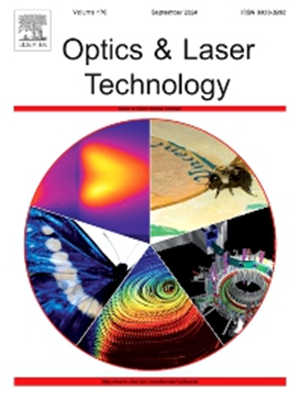Degradation mechanisms of optical properties of KDP crystals induced by nanosecond laser
IF 4.6
2区 物理与天体物理
Q1 OPTICS
引用次数: 0
Abstract
Potassium dihydrogen phosphate (KH2PO4, KDP) crystals are vital optical materials in Inertial Confinement Fusion (ICF) engineering. Optical properties of KDP crystals induced by nanosecond laser with two wavelengths at different energy densities were investigated by means of ultraviolet–visible (UV–Vis) transmission spectra, infrared (IR) transmission spectra and Raman scattering spectra. Results from UV–Vis spectra showed that transmittance of KDP crystals increased, accompanied by a general reduction in refractivity index, extinction coefficients and photoconductivities after irradiation. Infrared spectra revealed that the KDP crystal successively underwent a breakage of hydrogen bonds, dehydration and formations of new phosphates, as well as recombination of broken segments with an increase in laser energy densities. Raman spectra analysis primarily exhibited that vibration modes of PO43− and H2PO4− groups became disorder, and a new vibration mode, related to P![]() O bonds appeared with respect to energy densities after irradiation with two-wavelength laser. Furthermore, the results from three analysis techniques consistently suggests that KDP crystals were damaged firstly, then repaired, and finally damaged again, with an increase of energy density. And 355 nm laser induced more serious damages than that of 1064 nm laser at the same energy density. Similar damage processes were found after two-wavelength laser irradiation. Moreover, underlying degradation mechanisms in optical properties of KDP crystals were discussed in detail. This work provided insights into the full use of KDP crystal in ICF engineering.
O bonds appeared with respect to energy densities after irradiation with two-wavelength laser. Furthermore, the results from three analysis techniques consistently suggests that KDP crystals were damaged firstly, then repaired, and finally damaged again, with an increase of energy density. And 355 nm laser induced more serious damages than that of 1064 nm laser at the same energy density. Similar damage processes were found after two-wavelength laser irradiation. Moreover, underlying degradation mechanisms in optical properties of KDP crystals were discussed in detail. This work provided insights into the full use of KDP crystal in ICF engineering.
纳秒激光诱导 KDP 晶体光学特性的退化机制
磷酸二氢钾(KH2PO4,KDP)晶体是惯性约束聚变(ICF)工程中的重要光学材料。通过紫外-可见(UV-Vis)透射光谱、红外(IR)透射光谱和拉曼散射光谱,研究了 KDP 晶体在两种波长、不同能量密度的纳秒激光诱导下的光学特性。紫外可见光谱的结果表明,KDP 晶体的透射率增加,同时折射率、消光系数和光导率在辐照后普遍降低。红外光谱显示,随着激光能量密度的增加,KDP 晶体先后经历了氢键断裂、脱水和新磷酸盐的形成,以及断裂段的重组。拉曼光谱分析主要显示,PO43- 和 H2PO4-基团的振动模式变得紊乱,在双波长激光照射后,出现了与 PO 键有关的新的振动模式。此外,三种分析技术的结果一致表明,随着能量密度的增加,KDP 晶体首先受损,然后修复,最后再次受损。在相同能量密度下,355 nm 激光比 1064 nm 激光造成的破坏更严重。双波长激光照射后也发现了类似的损伤过程。此外,还详细讨论了 KDP 晶体光学特性的潜在退化机制。这项工作为 KDP 晶体在 ICF 工程中的充分利用提供了启示。
本文章由计算机程序翻译,如有差异,请以英文原文为准。
求助全文
约1分钟内获得全文
求助全文
来源期刊
CiteScore
8.50
自引率
10.00%
发文量
1060
审稿时长
3.4 months
期刊介绍:
Optics & Laser Technology aims to provide a vehicle for the publication of a broad range of high quality research and review papers in those fields of scientific and engineering research appertaining to the development and application of the technology of optics and lasers. Papers describing original work in these areas are submitted to rigorous refereeing prior to acceptance for publication.
The scope of Optics & Laser Technology encompasses, but is not restricted to, the following areas:
•development in all types of lasers
•developments in optoelectronic devices and photonics
•developments in new photonics and optical concepts
•developments in conventional optics, optical instruments and components
•techniques of optical metrology, including interferometry and optical fibre sensors
•LIDAR and other non-contact optical measurement techniques, including optical methods in heat and fluid flow
•applications of lasers to materials processing, optical NDT display (including holography) and optical communication
•research and development in the field of laser safety including studies of hazards resulting from the applications of lasers (laser safety, hazards of laser fume)
•developments in optical computing and optical information processing
•developments in new optical materials
•developments in new optical characterization methods and techniques
•developments in quantum optics
•developments in light assisted micro and nanofabrication methods and techniques
•developments in nanophotonics and biophotonics
•developments in imaging processing and systems

 求助内容:
求助内容: 应助结果提醒方式:
应助结果提醒方式:


